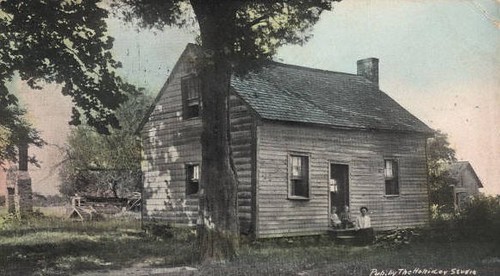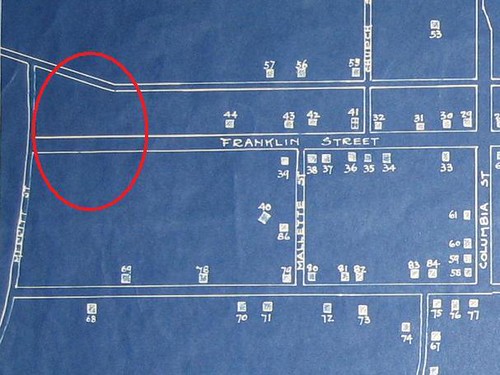
Although John Craig donated only 5 acres, his family clearly owned some other land nearby. James Craig's farmhouse was known to the early students of the University as Fur Craig’s, as both Battle’s History and Hooper’s Tis Fifty Years Since tell us. It was called Fur Craig’s, as Battle says, “in distinction from the habitation of a man of the same name on the Durham road.” That is, it was not Near Craig’s; it was Fur Craig's. This picture from Steve Rankin is said to be Fur Craig's:

Battle hints at the location of Fur Craig’s: “James Craig lived in the house still [ie in 1910] occupied by one of his descendants in the extreme western part of the village . . . a favorite boarding house for those not adverse to long walks . . . a farm house a mile from the town.” Battle’s description would seem to place Fur Craig’s somewhere near Merritt Mill Road, nearly in what is now Carrboro.
The legal description of Alexander Piper's 1793 land donation to UNC (20 acres in what would later become downtown Carrboro) reads: “beginning at a post oak, James Craig's corner, thence West 80 poles . . .” clearly indicating that Craig’s land was just east of the Piper donation, which would place it just east of Carr Mill Mall.
UNC sold the Piper donation to James Craig's son, John M. Craig, in 1837 (Orange DB 28, pg 272). And John M. Craig sold a larger parcel in 1867 “lying on the western outskirts of Chapel Hill upon both sides of the road leading from Chapel Hill to Greensboro adjoining the lands of John Weaver, Thomas Weaver . . . beginning at the mud hole in Craigs Lane . . . to a locust on the road leading to Greensboro . . . to a rock in the road from Chapel Hill to Jones Ford on Haw River . . . containing 101 ½ acres more or less." So the property straddled Weaver Street (the road leading to Gboro) and was bounded on the south by Jones Ferry Road (the road from CH to Jones Ford). This must have constituted most of downtown Carrboro, including the Piper donation and then some.
But it is also clear that the John M. Craig tract was not “Fur Craig’s” as Battle mentions that the Craig’s still lived there in 1910, whereas John M Craig sold that tract in 1867. Also an 1879 further conveyance of the John M Craig tract to Henry H Patterson and Fendal S Hogan (ODB 46, pg 257) mentions specifically that James F. Craig owned land just to the east. Battle tells us: “James Francis Craig, his [James Craig’s] grandson, a student of the University in 1852, recently [1910] died on the old homestead.” Also, I believe James F. Craig was a member of the Chapel Hill Board of Commissioners (now Town Council) in the 1880’s, suggesting the Fur Craig’s may have been within town limits in the 1880's (ie east of Merritt Mill Road.)
So the upshot of that would seem to be that Fur Craig’s must have been somewhere east of Merritt Mill Road, more or less in the vicinity of what is now Greenbridge. However, the Map of Chapel Hill as it was 1875-1885 shows no dwelling in that area:

Battle relates that James Craig “was a quiet, reserved, good man, so absent-minded that on one occasion he rode on horseback to New Hope church and then walked home about seven miles, forgetting that he had a horse, saddled and bridled, hitched near the church door. I heard President Andrew Johnson, in a speech delivered from President Swain's front steps, tell how, when on his way from Raleigh to seek his fortune in Tennessee, having walked from Raleigh, 28 miles, penniless and weary, he begged for a supper and a night's lodging at James Craig's. With softened voice he spoke of the cordial hospitality with which he was received, and how after abundant meals and a good night's rest he was cheered on his lonely journey by kind words and a full supply of food in his pockets.”
ReplyDeleteBattle also tells us: “I remember that on one sad occasion a squad of unfortunates, among them one destined to be an eminent Confederate general, whose hands bore the signs of the presence of the dreaded sarcoptes scabei, were quarantined at this remote spot in sulphurous loneliness, under the sway of the terrible demon, ‘Old Scratch.’”
Hooper includes this appealing description: “Shall he ramble into the country after fruit, or shall he go a fishing, or shall he make up a party and engage a supper in the suburbs, at "Fur Craigs?" The last measure was often adopted, because of our hard fare at Commons. Accordingly a party of some half dozen would go out and engage a supper of fried chicken, or chicken pie, biscuit and coffee. It was waited for with extreme impatience, and many yawnings and other symtoms of an aching void. At length it came upon the table, like the classical coena of the Romans, about three or four, P. M. The guests sat down, at twenty-five cents per head; and if you consider the leanness of our dinners at the Steward's Hall, you will be apt to suspect that the entertainer did not make much by that bargain.”
Nice work, Mark. Thanks for the historical post.
ReplyDelete